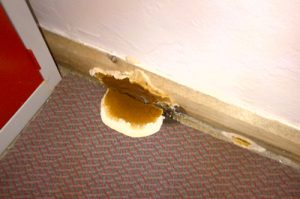Beaver dam

The beaver sponge is made up of tiny threads, colourless at first, which the human eye cannot see. The beaver’s tail then starts to develop and only when it joins is the beaver’s tail visible. The fungal body resembles white cotton wool, which over time develops a film or crust-like coating. The fruiting bodies then form and secrete a brown, powdery pus. Wind and insects are generally the main sources of mould, but mould can also be introduced into building structures with new wood.
Wood that is too damp for the fungus is a very fertile ground for the further spread of the beetle. Water is released from wet wood and the fungus is able to transport water into dry structures by means of a thread. During transport, water is formed as droplets on the surface of the wood, hence the name “weeping fungus”. The moisture source can be as close as 2-6 metres from the edge of the meadow, which still makes the fungus’ range very wide. In favourable growing conditions, the beetle can invade an entire building, from the basement to the attic.
